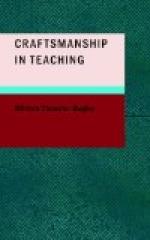It is a simple matter to construct in imagination an ideal teacher. Mix with immortal youth and abounding health, a maximal degree of knowledge and a maximal degree of experience, add perfect tact, the spirit of true service, the most perfect patience, and the most steadfast persistence; place in the crucible of some good normal school; stir in twenty weeks of standard psychology, ten weeks of general method, and varying amounts of patent compounds known as special methods, all warranted pure and without drugs or poison; sweeten with a little music, toughen with fifteen weeks of logic, bring to a slow boil in the practice school, and, while still sizzling, turn loose on a cold world. The formula is simple and complete, but like many another good recipe, a competent cook might find it hard to follow when she is short of butter and must shamefully skimp on the eggs.
Now the man whose history I have recounted represents the most priceless qualities of this formula. In the first place he possessed that quality the key to which the philosophers of all ages have sought in vain,—he had solved the problem of eternal youth. At the age of sixty-five his enthusiasm was the enthusiasm of an adolescent. His energy was the energy of an adolescent. Despite his gray hair and white beard, his mind was perennially young. And that is the only type of mind that ought to be concerned with the work of education. I sometimes think that one of the advantages of a practice school lies in the fact that the teachers who have direct charge of the pupils—whatever may be their limitations—have at least the virtue of youth, the virtue of being young. If they could only learn from my hero the art of keeping young, of keeping the mind fresh and vigorous and open to whatever is good and true, no matter how novel a form it may take, they might, like him, preserve their youth indefinitely. And I think that his life gives us one clew to the secret,—to keep as close as we can to nature, for nature is always young; to sing and to whistle when we would rather weep; to cheer and comfort when we would rather crush and dishearten; often to dare something just for the sake of daring, for to be young is to dare; and always to wonder, for that is the prime symptom of youth, and when a man ceases to wonder, age and decrepitude are waiting for him around the next corner.
It is the privilege of the teaching craft to represent more adequately than any other calling the conditions for remaining young. There is time for living out-of-doors, which some of us, alas! do not do. And youth, with its high hope and lofty ambition, with its resolute daring and its naive wonder, surrounds us on every side. And yet how rapidly some of us age! How quickly life seems to lose its zest! How completely are we blind to the opportunities that are on every hand!
And closely related to this virtue of being always young, in fact growing out of it, the ideal teacher will have, as my hero had, the gift of gladness,—that joy of living which takes life for granted and proposes to make the most of every moment of consciousness that it brings.




